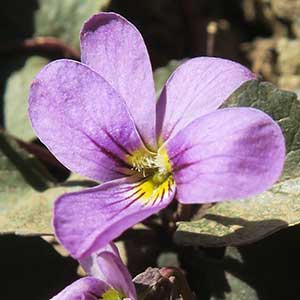Viola flettii
Viola orbiculata
Flett's violet, Olympic violet, rock violet
darkwoods violet, evergreen yellow violet, round-leaf or round-leaf wood or western round-leaf or evergreen violet, round-leaf violet, violette orbiculaire
1–3, ascending to erect, mostly glabrous, on caudex from fleshy rhizome.
1–5, prostrate or erect, leafy proximally and distally, usually glabrous, from current and/or previous year’s growth, on usually vertical, fleshy rhizome.
basal and cauline;
basal: 1–3;
stipules linear-lanceolate, margins entire or with glandular processes, apex acuminate;
petiole 1.5–9.7 cm, mostly glabrous;
blade purple-tinted and –veined, broadly reniform to ovate, 0.9–2.4 × 1.2–4 cm, base cordate, margins finely crenate-serrate, eciliate, apex acute to obtuse, surfaces glabrous or sparsely pubescent along veins adaxially;
cauline similar to basal except: stipules ovate to lanceolate, margins entire or shallowly laciniate;
petiole 0.7–5.9 cm, usually glabrous;
blade 0.8–2.1 × 1.2–3.1 cm.
basal and cauline;
basal: 3–11;
stipules deltate to lanceolate, margins entire, apex acute to acuminate;
petiole 2.1–10.5 cm, glabrous or pubescent;
blade usually orbiculate to broadly ovate, sometimes reniform, 1.4–5.3 × 1.4–5.3 cm, base cordate, margins crenate to serrulate-crenulate, eciliate or sparingly ciliate, apex usually obtuse, rarely acute, abaxial surface usually glabrous, adaxial surface sparsely pubescent;
cauline similar to basal except: stipules lanceolate to ovate, margins usually entire, ciliate;
petiole 0.7–1 cm, glabrous or pubescent;
blade 1.2–2 × 1.1–1.4 cm.
1.8–7.1 cm, usually glabrous.
2.7–5.6 cm, glabrous.
sepals lanceolate, margins eciliate, auricles 0.5–1.5 mm;
petals soft reddish violet on both surfaces, all with yellow area basally, lower 3 dark violet-veined, lateral 2 bearded, lowest with white around yellow area, 10–15 mm, spur yellow, gibbous, 0.5–2 mm;
style head bearded; cleistogamous flowers axillary.
sepals narrow to broadly lanceolate, margins eciliate, auricles 0.5–1.5 mm;
upper 2 and lateral 2 petals deep lemon-yellow on both surfaces, lower 3 and sometimes upper 2 brownish purple-veined, lateral 2 usually bearded, lowest 8–17 mm, spur usually yellow, sometimes whitish, gibbous, 1.5–2.5 mm;
style head bearded; cleistogamous flowers axillary.
± spherical, 5–9 mm, glabrous.
ellipsoid, 6–8 mm, glabrous.
dark brown to brownish purple, 2.5–3 mm.
light to dark brown, sometimes mottled with white, 2–2.3 mm.
= 24.
Viola flettii
Viola orbiculata
Viola flettii is endemic to the Olympic Mountains of northwestern Washington. C. S. McCreary (2005) noted that although morphologically and ecologically distinct, V. cuneata, V. flettii, and V. ocellata are closely related.
(Discussion copyrighted by Flora of North America; reprinted with permission.)
During winter, the basal leaves of Viola orbiculata are appressed to the ground under the weight of snow. The leaves overwinter and are often partly or entirely green after the snow has melted. Mature plants possess 3–11 basal leaves, some derived from previous years and others from the current year’s growth. Occasional plants are found with short, thin stems rooted at the tip and producing a rosette of leaves and stems, showing the close relationship with V. sempervirens.
(Discussion copyrighted by Flora of North America; reprinted with permission.)


